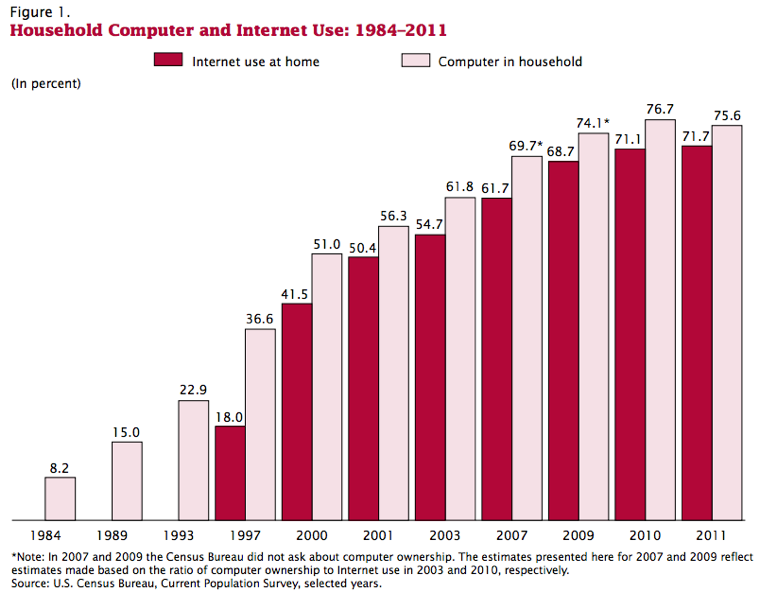The Success of Digital Services Heavily Relies on Internet Access
Everything from job applications to healthcare services has made the move to online, but it’s important to remember that the Internet isn’t free. Prohibitively high costs and struggling local infrastructure have created a chasm between the haves and the have-nots.
Known as digital inequality or the digital divide, the issues of affordability and universal access to the Internet have become increasingly important as governments embrace digital services.
The U.S. Census Bureau has established a connectivity continuum scale to measure levels of Internet access across a spectrum of characteristics, such as citizen age and location. The recent census (PDF download) revealed that many of the Southern states fall behind the rest of the United States in the percentage of connected individuals. Here’s a look at home computer and Internet use since 1984:

But it is not only geography that plays a role in the digital divide at the state and local levels. The issue is multifaceted and incredibly fragile. In order for citizens to be able to engage in meaningful activity online, both the speed and the reliability of the access has to be optimized.
Connecting Citizens to a Digital Government
The demand for bandwidth is increasing, and as online services become more complex, the traditional models of Internet access no longer suffice. Broadband infrastructure needs to be improved and properly funded to make governments truly digital.
As reported in StateTech Magazine’s Summer 2013 issue, Howard County, Md., is a prime example of a local government making strides toward providing the foundation for universal access. The new broadband project includes 1,000 additional miles of fiber throughout Maryland and 1,000 new connections.
The success of state and local broadband projects depends on funding. The New York Times reports that the Obama administration has boosted funding distribution to ensure nationwide connectivity:
The Obama administration allocated $7 billion to broadband expansion as part of the 2009 economic stimulus package. Most of it went to build physical networks. About half of those infrastructure programs have been completed, with Internet availability growing to 98 percent of homes from fewer than 90 percent. About $500 million from the package went toward helping people learn to use the Internet.
Broad federal programs are an excellent step in the right direction, but there is more that needs to be done. Funding doesn’t come easily, and the basics of digital access are essential.
State and local governments are uniquely equipped to understand the needs and wants of their communities. Every community is different, and that means the solution to the digital divide is complex.
What Does the Future Hold?
Innovation at the local level will address the issues of connectivity and knowledge. Unfortunately, the digital age waits for no one. Steps need to be taken quickly and effectively to provide a gateway to the online realm.
Internet access doesn’t have to be a luxury. With the proper scaffolding, programs can go a long way toward meeting the needs of every member of a community at a lower cost. The Cleveland Public Library system has found a way to leverage technology to ensure citizens are not cut off from the Internet:
The library offers computers to help close the digital divide within its community. "The bridge was out," says Acting IT Director Larry Finnegan. A big step toward solving the problem was to provide patrons with devices on which to save their work. Cleveland Public Library created the MyCloud service, which offers users access to mobile HP thin clients to create accounts and save their work. The library has 120 thin clients spread throughout its 28 branches.
Local initiatives focused on libraries are a great way to increase digital literacy, because people usually feel comfortable learning and experimenting in that environment. If connectivity at home is not possible, the community library is the next best place to provide access and opportunity.
From small business owners to students, the ability to learn online skills and participate in the global Internet economy is increasingly integral to lifetime success. State and local governments cannot afford to ignore the impact of excluding members of society from the Internet revolution.








